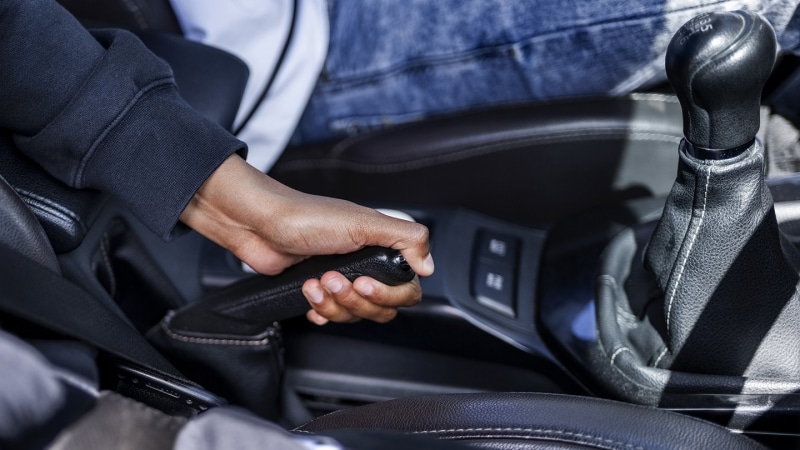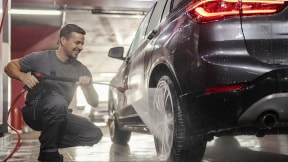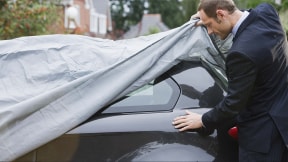When should you use your parking brake?

Quick insights
- Your car’s “parking brake” and “emergency brake” are part of the same secondary braking system, used in different contexts.
- It’s best practice to engage the parking brake every time you park to prevent damage and check for issues.
- Outside of inclement weather conditions, the emergency brake can be used to stop your car when the primary braking system has failed.
Whether you’ve been driving for a while or you’re new to being behind the wheel, you may have questions about your car’s parking brake. It’s worth mentioning up front that the terms “parking brake” and “emergency brake” both refer to the same mechanism, used alternately depending on the situation. In this article, we’ll describe when to use your car’s secondary braking system as a parking and emergency brake, and how proper use can help you maintain your vehicle’s value.
Understanding your car's braking system
When it comes to your car’s movements, “stop” is twice as important as “go.” To help keep drivers safe on the road, cars are built with two separate braking systems, with varying use cases and technology:
- The primary braking system (hydraulic): Used intermittently while driving, your car’s hydraulic braking system transfers force by the pressure and flow of oil within a closed system.
- The secondary braking system (mechanical): Used for stable parking and emergency stops, your car’s mechanical braking system is controlled by a lever or button which physically pulls on the wheels to stop them in place.
How parking brakes work
The secondary brake in your car typically takes the form of a lever on the driver’s right-hand side, though it may vary in appearance depending on make and model. Instead of a lever, some modern cars have a button that electrically activates the secondary braking system, which may instead be referred to as an “electronic brake,” “e-brake” or “handbrake.”
Whether it is a lever or a button, the secondary brake controls a system that mechanically halts movement of the wheels on your car. When activated, the lever pulls on a cable that squeezes the brakes into the wheels, causing the car to stop. When disengaged, the cable loosens, allowing the wheels to once again move freely.
When to use your parking brake
Some people have been taught that this secondary brake only needs to be used when parking on an incline, but this is not the case: It is a best practice to engage your parking brake every single time you park your car. Not only can this help prevent your car from sliding, but it can also reduce stress on the car’s transmission, which is the part that will otherwise engage to steady the car in its spot. Additionally, engaging the parking brake before shifting your car into ”park” can also help prevent damage to the transmission.
In emergency situations
In certain emergency situations, your “parking brake” becomes your “emergency brake,” and you may need to use it to bring your car to a halt. You should use your emergency brake when the primary braking system is failing, and the weather is non-threatening. To engage the secondary brake in an emergency situation, pull gradually on the lever to mechanically halt the wheels and come to a full stop.
When not to use your parking brake
Using your secondary brake for emergency stops in inclement weather is not recommended. Emergency brakes are known to be less effective (and even dangerous) in wet and freezing weather conditions. Using your emergency brake when the road is slick can cause dangerous sliding and further loss of control while driving. Emergency brakes can also be less effective when temperatures are below freezing, as they may seize up and fail to work as designed.
Remember to disengage before driving
Be sure to fully disengage your parking brake before you hit the gas, as driving with it still engaged can cause overheating and damage to the system. It’s also not recommended to use your parking brake in place of your primary brake, as it can be both dangerous and damaging to do so. Many modern cars disengage the parking brake automatically, so if you drive a newer vehicle, you may not have to worry about disengaging.
Maintaining your parking brake
A proactive approach to vehicle maintenance can help keep your car in its best condition, both in terms of its functionality and value. Keeping your parking brake in good condition is no different. Steps you can take include:
- Check for corrosion or damage: If you’re comfortable to get below your car for a look, you can conduct a visual inspection of the secondary brake cables for signs of rust, corrosion or other kinds of damage. On most cars, these cables can be seen flowing from the driver’s side to the car’s braking wheels. Refer to your car’s specific driver’s manual for your system’s exact layout.
- Test your own braking system: You can check your parking brake’s effectiveness by parking on a mild incline, engaging the parking brake, and slowly lifting your foot off the underfoot brake pedal to check the hold. Be ready to re-engage the standard braking system if the car begins to slip.
- Seek professional services: You may want to bring your car in for professional inspections twice a year to ensure all components (including the secondary braking system) are functioning correctly and safely. Parking brake systems tend to require adjustments, cleaning and part-replacements at regular intervals.
Using your parking brake consistently and correctly can help prevent premature wear of both your car’s primary braking system and its transmission. If you plan to eventually sell your car, keeping your parking brake in good condition can help your investment retain value and resell at a higher price.
In conclusion
Knowing how and when to use your parking brake (or secondary brake) can make a big difference in terms of your car’s long-term safety and value. Getting into the habit of using it consistently when parking is one of the best ways to maintain its functionality while also checking for signs it's in need of maintenance. As with most points of car maintenance, enlisting an experienced car care professional can help ensure the parts on your car are safe and working correctly.



